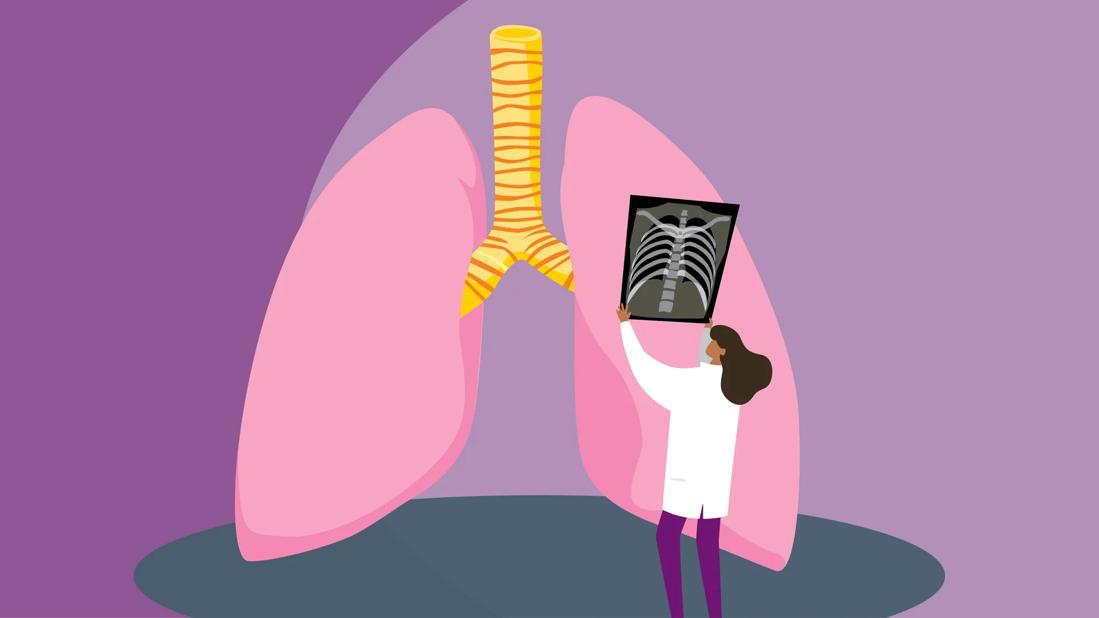Both are respiratory infections, but bronchitis affects your bronchial tubes, while pneumonia affects the air sacs in your lungs

Upper airway infections like a cold can leave your lower airways more vulnerable to viruses and bacteria, and that’s when bronchitis or pneumonia can strike. These respiratory infections share many similarities, yet they affect different parts of your respiratory system in different ways.
Advertisement
Cleveland Clinic is a non-profit academic medical center. Advertising on our site helps support our mission. We do not endorse non-Cleveland Clinic products or services. Policy
Pulmonologist Leslie Tolle, MD, explains how bronchitis differs from pneumonia and when you should seek treatment.
On the surface, it can be hard to tell the difference between bronchitis and pneumonia. The largest difference is where these infections occur:
Because pneumonia runs deep, it tends to come with more severe symptoms that affect your entire body (like chills, fever and muscle pain). Pneumonia can be life-threatening if it’s not treated or supported with care. But it’s common to also experience a milder form known as walking pneumonia, which often resolves on its own or with the help of treatment.
Bronchitis also has short- and long-term forms:
Advertisement
As bronchitis affects your upper airway, the most common symptom is a cough that may produce yellow-green mucus as your condition worsens. Other symptoms associated with bronchitis include:
Pneumonia shares a lot of the same symptoms as bronchitis but they tend to be more severe and last for longer periods of time. For example, it’s common to experience a cough for weeks after your pneumonia has resolved. And as pneumonia disrupts your body from getting all the oxygen it needs, more severe, widespread symptoms can include:
Without professional medical treatment, acute bronchitis tends to resolve on its own in just a few weeks, with the help of over-the-counter remedies that break up mucus, clear your sinuses and fight off fevers and aches. But if it’s caused by a bacterial infection, antibiotics might be the best course of action.
Chronic bronchitis, on the other hand, doesn’t fully go away on its own, and may require a variety of medications, therapies or even surgery depending on the damage that’s been done and how long you’ve had bronchitis.
Pneumonia can be treated by a healthcare provider with antibiotics (if it’s bacterial), antivirals (if it’s viral) or antifungals (if it’s a fungal infection). They may also prescribe inhalers to help you breathe easier if you’re dealing with rapid breathing or can’t take in a full breath. In many cases, it’s common to have a sore throat or cough weeks after pneumonia has resolved.
Bronchitis can turn into pneumonia if the original infection spreads from your bronchial tubes to the air sacs in your lungs. If your symptoms worsen, you have difficulty breathing or you’re short of breath, these may be signs your bronchitis has progressed farther into your lungs.
This is especially important to note because pneumonia is most harmful and life-threatening if:
If these characteristics apply to you and you’re dealing with worsening symptoms, see a healthcare provider for medical treatment right away.
Advertisement
Otherwise, you may want to consider adding the pneumonia vaccine to your list of recommended vaccines. It can help reduce your risk for bacterial pneumonia and lessen the severity of your symptoms if you were to get infected.
The bottom line? If you have symptoms that match either bronchitis or pneumonia and they don’t improve within a week, or if the symptoms keep worsening, contact a healthcare provider.
Advertisement
Learn more about our editorial process.
Advertisement

Simple solutions like adding moisture to the air and using nasal sprays can help ease your cough and other symptoms of the illness

Here's when to see a doctor about that persistent cough

When something like food or drink goes down your windpipe rather than your esophagus, it can cause coughing and sometimes choking

Covering your mouth when you cough and staying home when you’re sick are a couple ways to help keep yourself and others COVID-free

The virus often clears up on its own within two years, but it can also linger and can cause further complications

There’s no safe way to find, handle, repair or remove asbestos yourself — it’s always a job for a professional

We don’t fully understand how cleanliness impacts immune system development, but we do know that preventing illness is important

Stress can trigger and worsen asthma symptoms, like coughing and shortness of breath

If you’re feeling short of breath, sleep can be tough — propping yourself up or sleeping on your side may help

If you fear the unknown or find yourself needing reassurance often, you may identify with this attachment style

If you’re looking to boost your gut health, it’s better to get fiber from whole foods